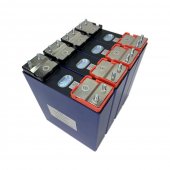- You have no idea what alloy the weld on terminal is made. The new terminal could very well be made of an alloy that can easily tolerate repeated use and not require the application of a permanent stud. Get some cells, do some research, ask the manufacture some quesitons but please quit making assumptions. It is only a "much better approach" if the new terminal threads are as delicate, short and poor quality as the ones that were threaded directly into the battery terminals.
Use of a harder allow would be great, but until that’s been confirmed, I’m an ‘err on the side of caution’ type of guy…
The only ‘benefit’ to using aluminum threads repeatedly is convenience. The hassle of even a 1% chance of stripping an aluminum terminal thread makes that convenience not worth it (at least to me, who has now had to deal with retapping 3 threads…).
- Torquing a bolt into the threads is the same/similar as torquing a nut onto a stud in terms of torque being applied to the welded connection and the batteries terminal. There is still a force being applied to the welded connection and therefor the battery terminal unless you are holding welded terminal.
In terms of force being applied to the aluminum threads, absolutely.
In terms of stainless-on-aluminum galling, absolutely not. Once you Loctite in a stainless grubscrew, your aluminum thread will be safe until you apply so much force that you sheer it off.
Each and every time you unthread a stainless bolt from an aluminum thread, you will remove some aluminum and ‘wear’ (degrade) the thread.
As far as torque, I believe we are in agreement, but the primary reason I am recommending the use of secured grubscrews is ‘better’ than direct use of the aluminum thread with stainless bolts is thread wear…
- Its not "going nuts" to apply the torque spec for a given fastener. You want the maximum clamping force at the connection.
Well first, there is no ‘spec’.
And second, once you find the appropriate curve showing contact resistance versus psi for a copper-on-aluminum connection, you will see that there is a point of diminishing returns above which you can ‘go nuts’ if you want, but you’ll likely be taking additional risk (of sheering threads) for little meaningful benefit…





